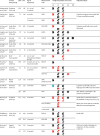Early neurodevelopment of HIV-exposed uninfected children in the era of antiretroviral therapy: a systematic review and meta-analysis
- PMID: 35483380
- PMCID: PMC9090907
- DOI: 10.1016/S2352-4642(22)00071-2
Early neurodevelopment of HIV-exposed uninfected children in the era of antiretroviral therapy: a systematic review and meta-analysis
Abstract
Background: There are 15·4 million children who are HIV-exposed and uninfected worldwide. Early child development crucially influences later academic and socioeconomic factors. However, the neurodevelopmental outcomes of HIV-exposed uninfected (HEU) children in the era of maternal antiretroviral therapy (ART) remain unclear. We aimed to examine the effects of in-utero exposure to HIV and ART on child neurodevelopment.
Methods: For this systematic review and meta-analysis, we searched MEDLINE, Embase, PubMed, Africa-Wide Information, PsycInfo, and Global Health databases from inception to May 27, 2020, for studies from the past two decades reporting neurodevelopment of HEU children aged 0-5 years compared with HIV-unexposed (HU) children (aim 1), and effects of different maternal ART regimens on neurodevelopment of HEU children (aim 2). We did narrative syntheses for both aims, and a random-effects meta-analysis of high-quality studies comparing HEU children and HU children, to obtain weighted pooled estimates of effect sizes. This study was registered with PROSPERO, CRD42018075910.
Findings: We screened 35 527 records and included 45 articles from 31 studies. Overall, 12 (57%) of 21 studies comparing HEU children and HU children found worse neurodevelopment in HEU children in at least one domain. Study design and methodological quality were variable, with heterogeneity across populations. Meta-analysis included eight high-quality studies comparing 1856 HEU children with 3067 HU children at ages 12-24 months; among HEU children with available data, 1709 (99%) of 1732 were exposed to ART. HEU children had poorer expressive language (effect size -0·17 [95% CI -0·27 to -0·07], p=0·0013) and gross motor function (-0·13 [-0·20 to -0·07], p<0·0001) than HU children, but similar cognitive development (-0·06 [-0·19 to 0·06], p=0·34), receptive language development (-0·10 [-0·23 to 0·03], p=0·14), and fine motor skills (-0·05 [-0·15 to 0·06], p=0·36). Results suggested little or no evidence of an effect of specific maternal ART regimens on neurodevelopment; study heterogeneity prevented meta-analysis.
Interpretation: HEU children are at risk of subtle impairments in expressive language and gross motor development by age 2 years. We found no consistent effect of maternal ART regimens analysed, although evidence was scarce. We highlight the need for large high-quality longitudinal studies to assess the neurodevelopmental trajectories of HEU children and to investigate underlying mechanisms to inform intervention strategies.
Funding: Wellcome Trust and Medical Research Council.
Copyright © 2022 The Author(s). Published by Elsevier Ltd. This is an Open Access article under the CC BY 4.0 license. Published by Elsevier Ltd.. All rights reserved.
Conflict of interest statement
Declaration of interests AJP declares paid participation on the Botnar Research Centre for Child Health independent external review board and is a member of several data and safety monitoring boards with no payment, none of which relate to the current research. DJS has received research grants or consultancy honoraria from Discovery, Johnson & Johnson, Lundbeck, Sanofi, Servier, Takeda, and Vistagen. All other authors declare no competing interests.
Figures






Similar articles
-
Growth trajectories of breastfed HIV-exposed uninfected and HIV-unexposed children under conditions of universal maternal antiretroviral therapy: a prospective study.Lancet Child Adolesc Health. 2019 Apr;3(4):234-244. doi: 10.1016/S2352-4642(19)30007-0. Epub 2019 Feb 15. Lancet Child Adolesc Health. 2019. PMID: 30773459
-
Growth of children who are HIV-exposed but uninfected: a systematic review and meta-analysis.Lancet Child Adolesc Health. 2025 Apr;9(4):234-247. doi: 10.1016/S2352-4642(25)00027-6. Lancet Child Adolesc Health. 2025. PMID: 40113365
-
Infectious morbidity of breastfed, HIV-exposed uninfected infants under conditions of universal antiretroviral therapy in South Africa: a prospective cohort study.Lancet Child Adolesc Health. 2020 Mar;4(3):220-231. doi: 10.1016/S2352-4642(19)30375-X. Epub 2020 Jan 10. Lancet Child Adolesc Health. 2020. PMID: 31932246 Free PMC article.
-
Neurodevelopment of HIV-Exposed and HIV-Unexposed Uninfected Children at 24 Months.Pediatrics. 2017 Oct;140(4):e20170988. doi: 10.1542/peds.2017-0988. Epub 2017 Sep 14. Pediatrics. 2017. PMID: 28912368 Free PMC article.
-
Clinical outcomes of HIV-exposed, HIV-uninfected children in sub-Saharan Africa.Trop Med Int Health. 2016 Jul;21(7):829-45. doi: 10.1111/tmi.12716. Epub 2016 May 20. Trop Med Int Health. 2016. PMID: 27125333 Review.
Cited by
-
Association of in utero HIV exposure with child brain structure and language development: a South African birth cohort study.BMC Med. 2024 Mar 22;22(1):129. doi: 10.1186/s12916-024-03282-6. BMC Med. 2024. PMID: 38519887 Free PMC article.
-
Maternal breastfeeding and education impact infant growth and development more than in-utero HIV/antiretroviral therapy exposure in context of universal antiretroviral therapy.AIDS. 2024 Mar 15;38(4):537-546. doi: 10.1097/QAD.0000000000003785. Epub 2023 Nov 14. AIDS. 2024. PMID: 37967230 Free PMC article.
-
Understanding HIV-Exposed Uninfected Children: A Narrative Review.Viruses. 2025 Mar 19;17(3):442. doi: 10.3390/v17030442. Viruses. 2025. PMID: 40143369 Free PMC article. Review.
-
Intelligence and language outcomes in school-aged children who are HIV-exposed, uninfected: the role of sex, perinatal risk factors, and socioeconomic status.Front Pediatr. 2025 Jul 17;13:1540420. doi: 10.3389/fped.2025.1540420. eCollection 2025. Front Pediatr. 2025. PMID: 40746358 Free PMC article.
-
Adverse perinatal outcomes associated with different classes of antiretroviral drugs in pregnant women with HIV.AIDS. 2025 Feb 1;39(2):162-174. doi: 10.1097/QAD.0000000000004032. Epub 2024 Oct 15. AIDS. 2025. PMID: 39407417 Free PMC article.
References
-
- Evans C, Jones CE, Prendergast AJ. HIV-exposed, uninfected infants: new global challenges in the era of paediatric HIV elimination. Lancet Infect Dis. 2016;16:e92–107. - PubMed
-
- Mofenson LM. Editorial commentary: new challenges in the elimination of pediatric HIV infection: the expanding population of HIV-exposed but uninfected children. Clin Infect Dis. 2015;60:1357–1360. - PubMed
-
- Le Doaré K, Bland R, Newell ML. Neurodevelopment in children born to HIV-infected mothers by infection and treatment status. Pediatrics. 2012;130:e1326–e1344. - PubMed
Publication types
MeSH terms
Grants and funding
LinkOut - more resources
Full Text Sources
Medical
Miscellaneous

